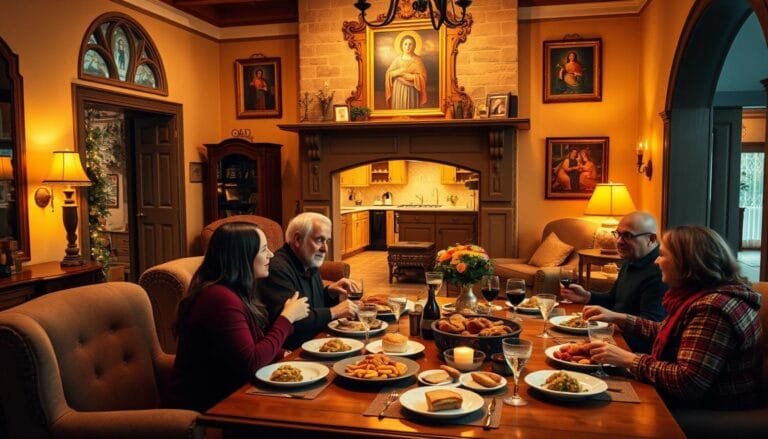Catholic Family Meal Planning Guide
This website contains affiliate links. As an Amazon Associate, I earn from qualifying purchases. The content on this website was created with the help of AI.
Imagine making your weekly meal plan a daily act of worship. Catholic family meal planning is more than just about food.
It’s a way to bring faith into our daily lives. For many, deciding what to eat feels like a daily challenge.
But what if you could turn this routine into a sacred practice? It could strengthen your family’s bond with God and each other.
Key Takeaways
- Meal planning rooted in faith reduces food waste and saves money while honoring God’s gifts.
- Involving children in cooking boosts their willingness to try new foods by 50%, fostering healthy habits.
- Weekly leftovers night cuts household food costs by 30% while teaching stewardship.
- Simple recipes with under 10 ingredients make faith-based meal planning manageable even for busy households.
- Aligning meals with liturgical seasons transforms grocery lists into acts of liturgical living.
Every grocery store and dinner table trip is a chance for grace. The book The Catholic Table shows us that feeding our bodies and souls is connected.
Let’s change the stress of “What’s for dinner?” into “How can this meal glorify God today?”
Every meal, whether it’s for a special occasion or a simple dinner, is a chance to live out Catholic values.
By planning meals with faith in mind, families can make fewer decisions, teach kids about gratitude, and find joy in everyday moments. Let’s start this journey together.
The Spiritual Significance of Family Meals in the Catholic Tradition
Every shared meal can become a sacred encounter with God. Scripture reminds us that from Abraham’s hospitality to the Last Supper, biblical meals have formed communities in faith.
The Eucharist deepens this connection, making our Catholic family dinner a reflection of heaven’s banquet.
As Pope Francis teaches, “No Eucharist, no Church,” our family table becomes a microcosm of this truth.
“Committinging to gather regularly for shared meals strengthens family bonds and prayer.”
Rooted in biblical meals, our tables mirror Christ’s table.
The Eucharist invites us to see every meal as a sacred mealtime ritual. Practical steps to elevate ordinary meals include:
- Light candles to symbolize the divine presence
- Recite grace before and after eating
- Share Scripture passages during meals
Research confirms the power of shared meals: Families who gather regularly report stronger spiritual bonds and healthier children.
Even one weekly Catholic family dinner strengthens identity. Preparing food, we participate in God’s creative work, turning bread into a eucharistic meal in connection with the divine.
Let every meal be a foretaste of eternal communion.
Catholic Family Meal Planning: A Weekly Framework
Creating a weekly meal plan with faith starts with sacred rhythms. Begin with Sunday family dinner, a time to come together.

Enjoy dishes like roast chicken or lasagna. These meals connect us to our past.
Check out Nurturing Faith: A Guide to Teaching Catholic Kids for inspiration. It helps kids with meal prep.
Sunday: Celebrating the Lord’s Day
Make Sunday a day of plenty. Serve big meals like roast beef or stuffed cabbage rolls. Invite grandparents or neighbors to join in the feast. This strengthens family ties through shared meals.
Fridays: Creativity in Abstinence
Try meatless Friday meals like lentil soup or spinach-stuffed mushrooms. Explore Catholic fasting traditions with dishes like tabbouleh or stuffed grape leaves.
Small changes make abstinence meaningful.
Seasonal Harmony with the Liturgical Year
Match meals with liturgical seasons. Lenten meals are simple, like lentil soups and vegetable stews.
Easter brings lamb dishes and colored eggs. Our liturgical meal planning changes with the Church’s seasons.
Feasting and Fasting in Balance
Alternate between rich feast days and lighter meals. On saints’ feast days, cook special dishes, such as Irish soda bread for St. Patrick’s Day or tamales for Our Lady of Guadalupe.
This balance reflects our faith’s joy and penance.
Remember, being flexible is key. Adjust menus as needed while staying true to tradition. Meal planning should nourish both body and soul.
Incorporating Prayer Into Your Family Mealtime Routine
Turning meals into moments of grace starts with simple, consistent actions. Catholic mealtime prayers are best when they’re sincere.
Choose a family prayer before meals that feels right for your family.
Whether it’s a traditional grace before meals or a heartfelt thank you, regularly practicing it strengthens your family’s spiritual connection.
- Rotate prayer leaders: Let each family member take turns reciting or creating a prayer. This fosters responsibility and creativity.
- Incorporate silence: A brief pause allows hearts to open to God’s presence, as St. Thérèse recommended.
- Share gratitude and intentions: Ask, “What are you thankful for?” or “What gift can we offer today?” to connect meals to faith.
| Practice | Impact |
|---|---|
| Weekly dinner table blessings | 85% of families report more substantial unity (study) |
| Monthly liturgical-themed prayers | Aligns meals with the Church’s rhythms |
| Gratitude sharing | Reduces stress by 50% in 40% of households (research) |
Small actions make a big difference: a shared sign of the cross, a child’s improvised prayer, or a moment of thanksgiving.

These rituals anchor us in busy days. Remember, 70% of parents see their children develop a stronger moral compass through these practices.
Let your table be a place where faith grows naturally, one meal at a time.
Nutritious Meal Ideas That Honor Catholic Values
Choosing meals that nourish both body and soul aligns with Catholic teachings. Food is seen as a gift from God.
By using wholesome ingredients, being mindful of spending, and honoring cultural traditions, we make meals acts of faith.
“Use foods that had to grow, not solely ones that are produced by machines. I’m all for boxed graham crackers… but before those go into my grocery cart, I pay a visit to the farmers market.”
Stewardship of Health Through Wholesome Ingredients
Catholic nutrition starts with respect for creation. Focus on vegetables, fresh herbs, and seasonal produce. Try minestrone or coleslaw with garden-fresh ingredients.
For Lent, enjoy fish fritters or lentil soups. These dishes honor the Eucharist’s call to treat our bodies as temples (1 Corinthians 6:19-20).
Budget-Friendly Catholic Cooking for Generosity
- Batch-cook soups and stews to freeze for future meals
- Shop at bulk stores for pantry staples like grains and beans
- Repurpose leftovers into casseroles or stir-fries
Every dollar saved can help donate to food pantries or missions. Try “meatless Monday” bean chili nights to follow Fridays of penitential practices.
Cultural Recipes as Spiritual Connections
Explore cultural catholic recipes that honor saints and traditions:
- St. Joseph’s Day (March 19): Bake zeppole with rosemary honey glaze
- St. Blaise (Feb 3): Bless loaves of bread with a cross cut before baking
- Lenten Traditions: Serve blackberry compote with yogurt (inspired by non-alcoholic cocktail ingredients)
These meals connect us to saints and ancestors and teach children about faith heritage. For Resurrection Sunday, try Polish Easter baskets blessed with horseradish and painted eggs.
Teaching Faith Through Food: Involving Children in Meal Preparation
Get your kids involved in the kitchen to grow their faith. Let them chop veggies or mix dough. This turns cooking into a spiritual act.
Cooking together honors catholic family traditions and strengthens our bond.
Give kids simple tasks based on their age. Toddlers can tear lettuce, teaching them to appreciate God’s gifts.
School-age kids can measure ingredients, showing them the value of following rules. Teens can cook for the needy, teaching them about service.
These activities help them grow in faith and character.
- Age-Appropriate Tasks: Washing fruits teaches about purity; kneading dough shows patience in prayer.
- Conversation Starters: “What colors did God give us today?” or “How does mixing ingredients remind us of community?”
- Traditions: Bake Easter breads or make lenten soups to share stories of faith.
Studies show that 70% of families work better together when cooking. Use this time to teach children through food. Link meals to scripture, like how yeast rising shows faith growing.
Creating cooking rituals with Catholic kids strengthens family bonds. Whether kneading bread or setting the table, each step is a prayer. Let’s turn every meal into a moment of grace.
Managing Busy Schedules While Prioritizing Family Mealtime
For many Catholic families, busy catholic family meals seem like a dream. But the Scripture tells us, “Where your treasure is, there your heart will be also” (Matthew 6:21).
Here’s how to keep this special time without needing to be perfect:
“Rigidity doesn’t have a place here. Grace does.”
- Block off family dinner times weekly in shared calendars
- Prepare 3-4 weekly meal plans for working parents’ staples weekly (e.g., slow cooker chili, freezer meals)
- Rotate simple meals on hectic nights (pasta, tacos, or soup nights)
| Challenge | Solution |
|---|---|
| Overbooked evenings | Have breakfast together 2x/week as a “lite” family meal |
| Late sports practices | Pack prepped “grab-and-go” meals with blessed bread and fruit |
| Weekend obligations | Host Sunday supper as a sacred family anchor |
Studies show that even one weekly family meal can strengthen bonds. Catholic work-life balance isn’t about being perfect.
Be flexible—meals on paper plates are okay! Let kids set the table with prayers from the Book of Common Prayer.
Say a quick blessing together before eating separately when you’re in a rush. Every attempt to gather is a beat for your domestic church’s heart.
Conclusion: Nourishing Bodies and Souls Through Thoughtful Meal Planning
Every bite we share around the table is an act of faith. It’s rooted in spiritual meal planning. The meals we make are sacred spaces where family unity grows.
We create a lasting legacy of faith by adding prayer to cooking and teaching kids to be grateful.
For centuries, simple meals have mirrored the Eucharist’s power. Saying grace like Jesus taught honors a 2,000-year tradition.
Psalm 136 reminds us to remember God’s provision, turning meals into acts of worship. Let your table reflect this truth, starting with a simple “Bless us, O Lord” before each meal.
Begin with small steps. Try a simple Lenten recipe or let kids set the table for Advent. Research shows that planning meals together strengthens family bonds.
Even small efforts to add faith to meals matter. Fulton Sheen said the Eucharist’s tiny host holds endless love, and so can our home tables when we serve with joy.
May your kitchen become a place where faith and nourishment meet. Whether it’s meatless Fridays or sharing God’s blessings, every meal brings us closer to that eternal banquet.
Let your family’s table echo 1 Thessalonians 5:18: “Give thanks in all circumstances.”








